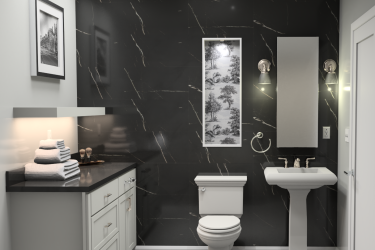How would you feel if we told you that bathing in the United States did not become popular until the late 1800s? One thought that may come to mind would be utterly disgusting! Thankfully, the trend of regular bathing and maintaining proper hygiene caught on. In the 1930s, J.L. Mott, a businessman and an innovator, produced cast iron tubs. Since his innovation, cast iron tubs maintain a steady fixture in most bathrooms in the country and globally.
Now that the history is out of the way, let us move to the real reason why you are reading this blog— to replace or to reglaze iron tubs once worn out. It all took place in Old Town Alexandria, where a homeowner decided to reglaze her cast iron tub instead of replacing, but was that a wise choice? Let’s have a look to find out!
The Dilemma
The homeowner’s cast iron tub complemented the age of the house, which was constructed in 1919. With time, the cast iron tub lost its shine, as uncovered in the bathtub were green water stains under the faucet, gritty texture and nasty dents on the outside. The cause of the condition of the bathtub was clear. The years of improper cleaning had taken a toll on it, but the technician could still breathe life into it, restoring it to its usual self.
Also Read : Metal Strips Versus Bullnose Tiles
The Restoration of the Cast Iron Tub Begins
The steps taken to give the cast iron tub a new beginning are as follows:
- Step 1: Using a putty knife, the technician carved away the caulk caught between the walls and the tub.
- Step 2: Next, he removed the drain cover and covered the faucets.
- Step 3: He cleaned the bathtub to remove the grime.
- Step 4: Using a razor blade, he scraped off soap scum, and then put an alkaline emulsifier.
- Step 5: Using an acid-based citric cleanser, he neutralized the emulsifier.
- Step 6: He cleaned the tub, dried it and rubbed it with denatured alcohol.
- Step 7: He sealed the scratches and chips with fiberglass putty.
- Step 8: He applied a coat of a bonding agent to allow the acrylic urethane enamel to hold to the porcelain surface.
- Step 9: Using a spray gun, he put on three coats of acrylic urethane enamel, giving each coat time to dry for at ten to fifteen minutes.
- Step 10: He smoothed out the rough patches with a 1,000-grit sanding paper and used a power buffer with a foam attachment to remove scratches.
After eight hours, the homeowner’s bathtub was ready for her to take a bath in. Reglazing the cast iron bathroom was the right choice for her after all, but is it a wise choice for you?
When Should You Replace or Reglaze Your Cast Iron Tub?
Replace your cast iron tubs for the following reasons:
- You have no need for a tub and prefer a shower instead.
- You want to replace it with a soaking, freestanding, or whirlpool bathtub.
- You have a personal vendetta against it and just want it out.
- You want a barrier free shower and want to remodel for aging in place.
Reglaze your cast iron tubs for the following reasons:
- You have a cast iron tub and reglazing a steel enameled tub is costly.
- You want to move the tub to any other location in the house.
- You don’t want to mess with the theme of the bathroom by changing the tub.
- You want to repaint the tub a different color, which you easily can with a cast iron tub.
- You plan to sell your house soon and reglazing it will save you money, saving you about $750, whereas replacing it would cost you anywhere from $600 to $1,500.
*Quick Tip: To find out if your cast iron tub is enameled steel, fiberglass or acrylic, knock on it and if it gives a silent thud – congratulations, you have a cast iron tub!
Also Read : 8 Tips For Small Bathrooms in Washington DC
Which is the right fit for you? Will you replace it or reglaze it? Whichever option you decide to go with, we will be there to do it for you!





